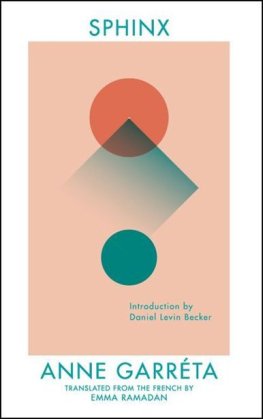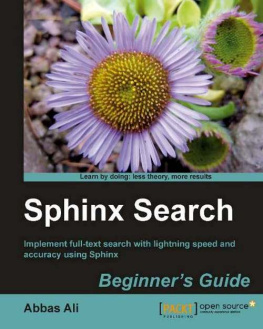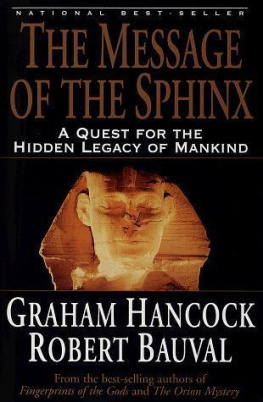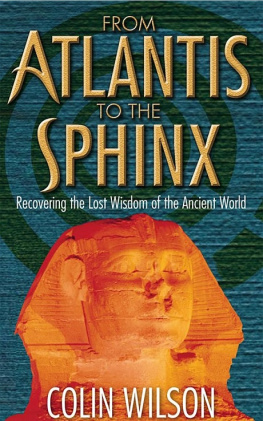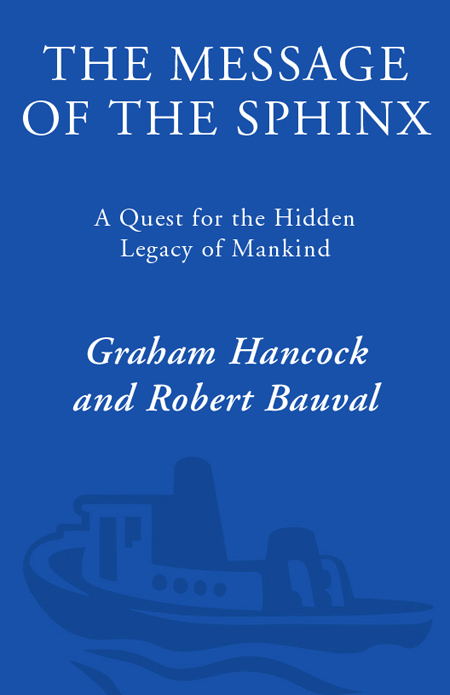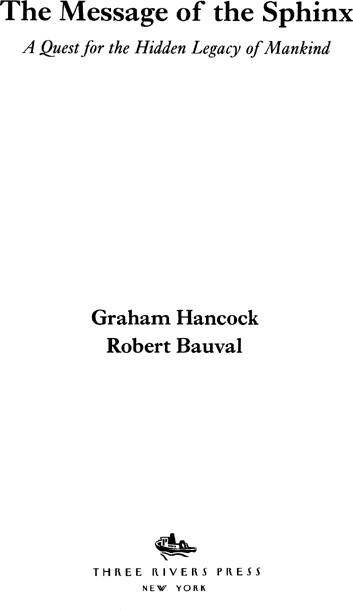Line Illustrations
Profile of the Great Sphinx from the south.
Overhead view of the principal monuments of the Giza necropolis.
The Great Sphinx and the architectural complex that surrounds it.
The artificial Horizon of Giza.
Geodetic location of the Great Pyramid of Giza.
Cross-section of the Great Pyramid of Egypt.
Internal corridors and passageways of the three Pyramids of Giza.
Principal internal features of the Great Pyramid.
Detail of the corridors, chambers and shafts of the Great Pyramid
The complex internal design of the Great Pyramid.
The King's and Queen's Chambers and their four shafts.
Details of the Queen's Chamber and its shafts.
Queen's Chamber wall and shaft mouth.
Construction details of the Great Pyramid shafts.
The summer solstice as seen from Giza.
The trajectory of the sun on the summer solstice.
The trajectory of the sun on the equinox.
The trajectory of the sun on the winter solstice.
The horizon of Giza and the meridian of the Great Pyramid.
Culmination (meridian-transit) of Orion's belt circa 2500 BC.
Orion and Osiris.
The stellar alignments of the Great Pyramid's four shafts.
Orion's belt crossing the meridian of the Great Pyramid in 2500 BC.
The sky-ground image of Giza-Orion's belt in 10,500 BC.
The 10,500 BC lock with Giza.
Artist's impression of Orion's precessional cycle at meridian.
The trajectory of Orion's belt throughout the ages.
Pre-dawn at the spring (vernal) equinox in 10,500 BC.
Superimposed images of the rising of Leo in 2500 BC and 10,500 BC.
Sunrise at the spring (vernal) equinox in 10,500 BC.
Artist's impression of the First Time of Osiris-Orion.
Sah (Osiris-Orion), the Tar Stricter.
Detail of Queen's Chamber shaft.
The Memphite necropolis.
Sunrise at solstices and equinoxes as seen from Giza.
The sky region of the Duat.
Map of the apex region of the Nile Delta.
The Land of Sokar in the Fifth Division of the Duat.
The Fifth Division of the Duat.
The summer solstice as seen from Giza circa 2500 BC.
The Denderah Zodiac.
Horakhti, Horus-of-the-Horizon.
Artist's impression of reconstructed Sphinx.
The Duat sky-region at dawn throughout the year, circa 2500 BC.
The solar Horus crossing the Milky Way.
The solar Horus in the paws of Leo.
The astral Kingdom of Osiris in Rostau.
The Horus-King being led into the Great Pyramid.
The astral Great Pyramid and its stargates.
The rising of Leo at the summer solstice circa 2500 BC.
The summer solstice circa 2500 BC.
The Horus-King statue between the paws of the Sphinx.
Osiris-Orion showing the way to his Followers, the Horus-Kings.
Arists's impression of the Mansion of the Phoenix.
Osiris-Orion, Isis-Sirius and the Horus-Kings.
Great conjunction of the ancient skies at the spring (vernal) equinox circa 10,500 BC
The sky-Duat and the ground-Duat of Osiris.
The drift of Orion from 10,500 BC to 2500 BC.
The setting of Orion's belt and the satellite pyramids of the horizon of Giza in 10,500 BC.
Artist's impression of the First Time of Sirius, in the epoch of 10,500 BC.
The course of the sun throughout the year as viewed from the latitude of Giza.
The 14 degree north of east alignment of the Khufu causeway at the north cross-quarter sunrise.
The due east (equinox) alignment of the Menkaure causeway.
The 14 degree south of east alignment of the Khafre causeway at the south cross-quarter sunrise.
The rising of Leo and the south cross-quarter sunrise in 10,500 BC.
Hor-em-akhet (Sphinx) gazing at Horakhti (Leo) at the south cross-quarter sunrise in 10,500 BC.
Profile of the Great Sphinx in the ground-horizon of Giza.
The place-time datum of 10,500 BC under Leo.
Possible locations of an underground system of passageways and chambers beneath the Great Sphinx.
The Djed pillar of Osiris, flanked by Isis and Nepthys.
Sun-boat on the back of the double-lion hieroglyph for Aker; Great Pyramid looking west; Osirian Djed pillar looking west.
The Scales of Maat.
Cross-sections of the Great Pyramid showing the balancing of the monument with the star-shafts.
The scales of Orion at the nadir and apex of the current Precessional Cycle and the ages of Leo (10,500 BC) and Aquarius (2450 AD).
Acknowledgements
Robert G. Bauval:
Foremost, a special thanks to the readers. In the last two years I have received hundreds of letters of encouragement and good-will and it's sure nice to know you're all out there sharing in this common quest for truth.
I am immensely grateful for the patience and understanding of my wife Michle, and my two children, Candice and Jonathan.
Particular gratitude goes to the following relatives, friends and colleagues for their support: John Anthony West, Chris Dunn, Bill Cote, Roel Oostra, Joseph and Sherry Jahoda, Joseph and Laura Schor, Niven Sinclair, Marion Krause-Jach, Princess Madeleine of Bentheim, James Macaulay, Robert Makenty, Linda and Max Bauval, Jean Paul and Pauline Bauval, my mother Yvonne Bauval, Geoffrey and Thrse Gauci, Patrick and Judy Gauci, Denis and Verena Seisun, Colin Wilson, Mohamed and Amin El Walili, Julia Simpson, Sahar Talaat, Professor Karl-Klaus Dittel and his wife Renate, Hani Monsef, Mark Ford, Peter Zuuring, Richard Thompson, Adrian Ashford, Dave Goode, Okasha El Daly, Mohamad Razek, Heike Nahsen, ilga Korte, Gundula Schulz El Dowy, Antoine Boutros, Professor Jean Kerisel, Roy Baker, Murry Hope, William Horsman and Charlotte Ames.
I would like to convey my warm thanks to Bill Hamilton and Sara Fisher of A.M. Heath & Co., Ltd, for putting up with my pleonastic ways, Tom Weldon and all the staff at William Heinemann Ltd, Peter St Ginna and Brian Belfiglio at Crown Publishing Inc., Melanie Walz and Doris Janhsen at Paul List Verlag, Udo Rennert of Wiesbaden, and Moheb Goneid and all the staff at the Movenpick-Jolie Ville at Giza.
Finally, I want to pay tribute to the engineer and my friend Rudolf Gantenbrink for opening the way for all of us with his bold and daring exploration in the Great Pyramid.
Robert G. Bauval,
Buckinghamshire, February 1996


